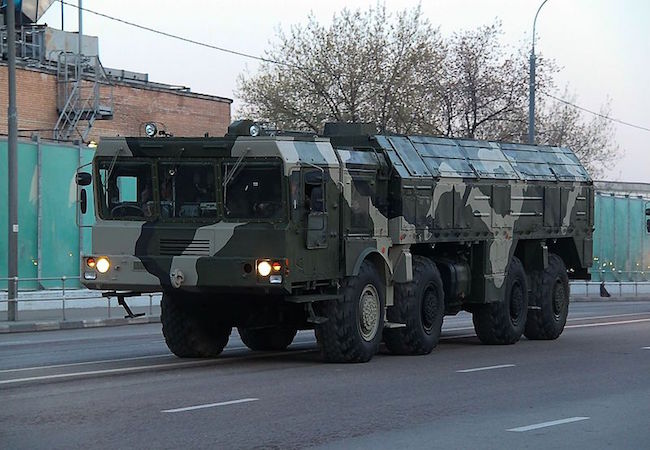
By Debalina Ghoshal
As Russia deploys “Iskander” tactical nuclear missiles to Kaliningrad, the country’s westernmost territory, Poland’s apprehensions have increased, with Warsaw calling the move “disturbing” and “alarming”. This is an understandable reaction when considering that Kalingrad borders Poland, a former satellite state of the Soviet Union. Poland’s apprehension towards Russia is not new, but in fact has its roots in the 1930s when, despite signing a “non-aggression pact” with Warsaw, the Soviet Union invaded Poland and proceeded to torture a countless number of its citizens. After World War II, Poland also lost some territory to the Soviet Union as it became a part of the Warsaw Pact and it was only after the Cold War that Poland gained its independence.
However, Poland’s apprehensions towards Russian activity north of its borders have undoubtedly intensified, especially after the Russia-Georgia conflict and even more so after the Ukrainian crisis. Poland feels that Russia’s actions in Crimea represent a “long-term trend of Russia shifting the momentum”, and the events in Ukraine are only the “first steps.” Warsaw further feels that Russia is attempting to regain “the power it lost after the break-up of the Soviet Union”, a reality that could deeply affect Moldova, Georgia, Poland, and the Baltic States (Lithuania, Latvia, and Estonia).
On October 6, 2014, The Daily Star reported that Poland had urged NATO’s new secretary general, Jens Stoltenberg, to go ahead with NATO’s missile defence system in Europe. Poland’s President, Bronislaw Komorowski, is reported to support the creation of this “pan-NATO” system since he believed that the system makes “deep sense both politically and in terms of defence.” Though the discussions on the missile defence system have not explicitly mentioned Russia as a target, there is little doubt that this may be the case, especially for Poland as it refers to the Ukrainian crisis time and time again. These threat perceptions have become so pointed that Poland could also alter its earlier decisions and instead opt to acquire a domestic defence system produced by Polish industries.
Here, it is indeed quite surprising that in July 2014, Poland chose to scrap the development of the Medium Extended Air Defence System (MEADS) that was a joint venture of the United States, Germany, and Italy intended to replace the Patriot systems in the US, the Hawk systems in Germany, and the Nike Hercules systems in Italy. Reports, however, confirm that Poland was more interested in fielding a defence system for its Wisla project that is already employed by NATO countries due to “operational urgency.”
In fact, one of the major reasons why MEADS was not chosen as Poland’s missile defence system was because it has not yet been deployed by any other NATO state. In early July 2014, reports came in that Poland has now short-listed Raytheon’s Patriot in its anti-missile system bidders list. This of course is because the Patriot is already fielded by NATO states, namely Germany, Spain, Greece, and the Netherlands and of course the United States. Another bidding contender on the top of the list is the EUROSAM consortium with its SAMP/T model.
However, being battle-tested, the Patriot system is surely a favourite of this state which is looking for combat-proven capability. In addition to this, the system is also continuously being modernised in order to address new threats, thereby it possesses the capability to evolve as a state-of art capability. In this regard, in June this year, Raytheon and Poland agreed to jointly develop a “modernised Identification Friend-or-Foe Antenna” for the Patriot air defence system. This would be an integral component of the advanced 360 degree radar of the Patriot. These are secondary radar systems which work independently from the primary radar systems.
Along with this, it is also planned by the United States, under the European Phased Adaptive Approach, to field missile defence components in Poland, which according to US Secretary of State John Kerry, would be operational by 2018. With recent reports coming in that the United States has already “assumed control of a missile defence base in southern Romania” as a part of the NATO missile defence shield, the proposed plan of making the Poland-based missile defence component operational by 2018 is surely a possibility.
Reports confirm that Poland would employ the SM-3 IIA interceptor missile which would be more powerful and possess a longer range than the SM-3 IB interceptor missile to be deployed at the Romanian Aegis Ashore site. This Block II interceptor missile would provide more coverage to Poland than the Block I interceptors and can destroy short range ballistic missiles and intermediate range ballistic missiles, while also possessing “some capabilities against intercontinental ballistic missiles.”
The United States has always made clear to the Russians that the European Phased Adaptive Approach system is meant to counter threats from Iran and not to negate Russia’s nuclear deterrent. Nonetheless, it seems that Poland’s military modernisation program, amongst which missile defence system procurement is high on the agenda, is eyeing threats from Russia rather than from Iran. Thus, amid varied threat perceptions, it is fitting for Poland to also concentrate on an indigenous missile defence system in order to be able to address its own threat perceptions. The importance of doing so is further supplemented by the fact that the NATO missile defence shield would already have several command and control issues due to the varied perceptions of threat.
Nevertheless, it can be rightly concluded that Eastern Europe is becoming a nuclear flashpoint.
Debalina Ghoshal is an associate fellow at Centre for Air Power Studies, New Delhi.




